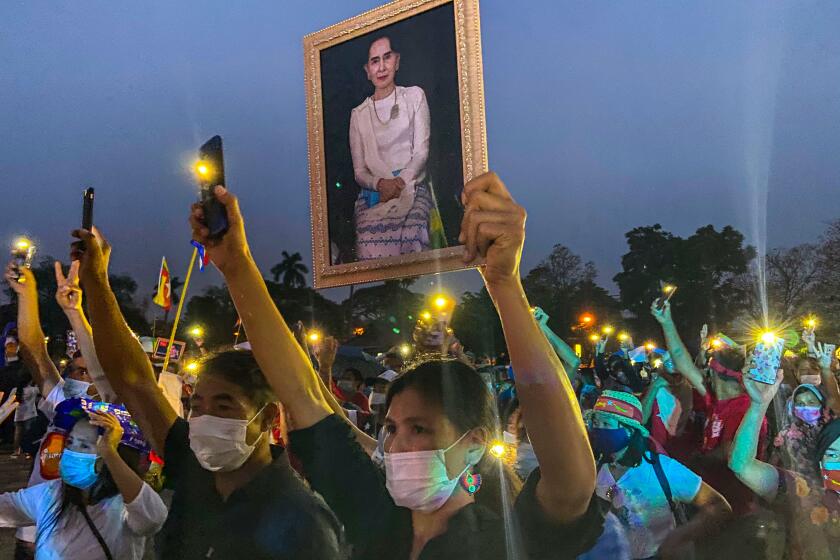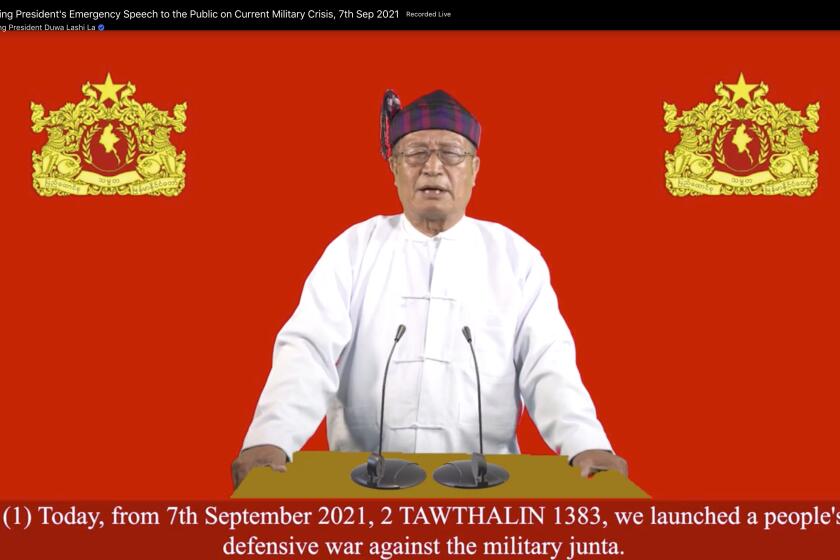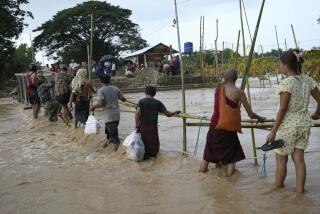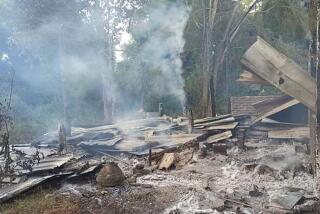‘My friends are being burned’: Atrocities mount under Myanmar’s junta
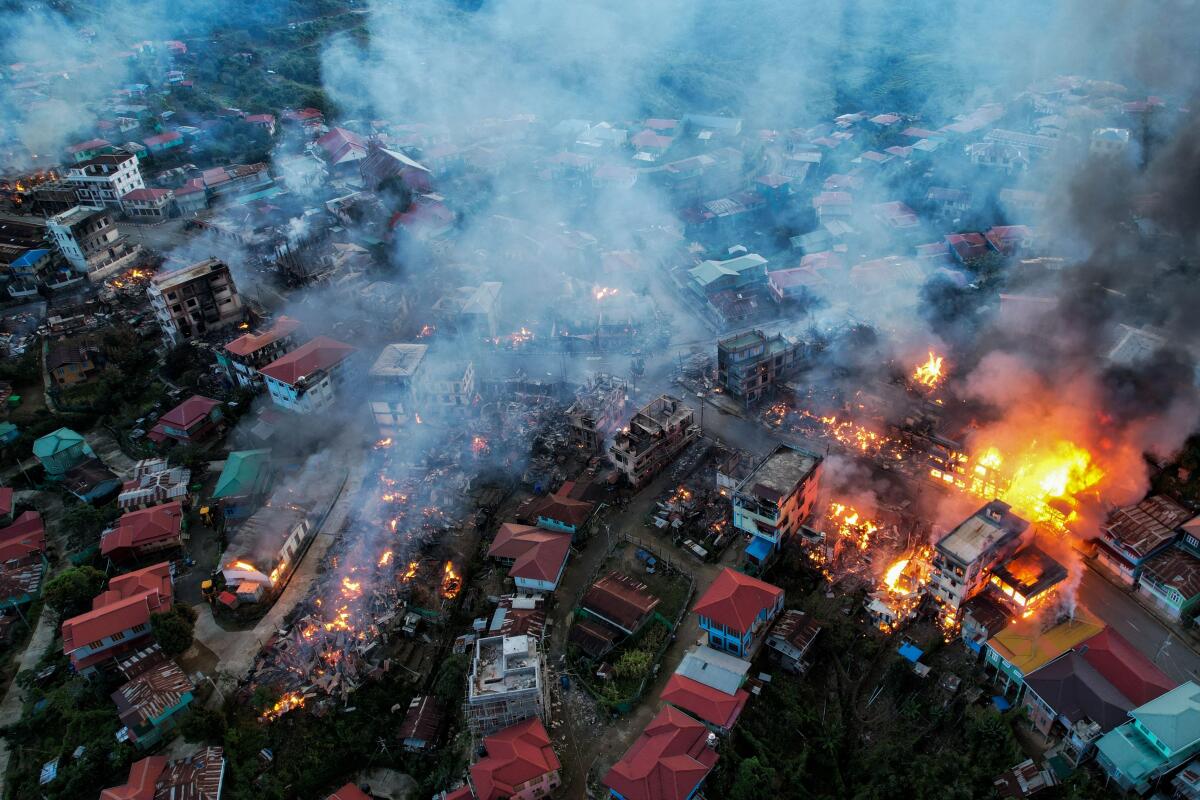
- Share via
SINGAPORE — One person appears to have been trying to crawl to safety. Two others are locked in a haunting embrace on the ground. A few of the corpses have their hands tied.
The charred remains of the 11 villagers in northwestern Myanmar tell the grisly story of their final moments. They were rounded up and beaten by soldiers hunting down resistance fighters. Some, if not all, were shot before they were trapped inside a hut next to a betel farm and set alight.
For the record:
3:09 p.m. Dec. 15, 2021An earlier version of this report incorrectly said Myanmar was brought before the International Criminal Court in 2019 when it was accused of genocide against the Rohingya. It was brought before the International Court of Justice.
“We saw the smoke, but we thought the soldiers were just burning houses. Then someone close by came screaming and crying, saying, ‘My friends are being burned,’” said Ko Sithu, a teacher in the village, Don Taw. “I felt helpless because there was nothing I could do. I’ve never seen anything like this in my life. I don’t know how the junta could do such a thing.”
The Dec. 7 killings were reportedly in retaliation for a nearby bomb attack on a military convoy by guerrilla fighters, who have used land mines and improvised explosive devices to kill a growing number of soldiers. The slaughter of the villagers adds to a lengthening list of atrocities committed by the military junta, which seized power of the impoverished Southeast Asian nation in a Feb. 1 coup and has been fighting an intensifying battle against rebel volunteers since.
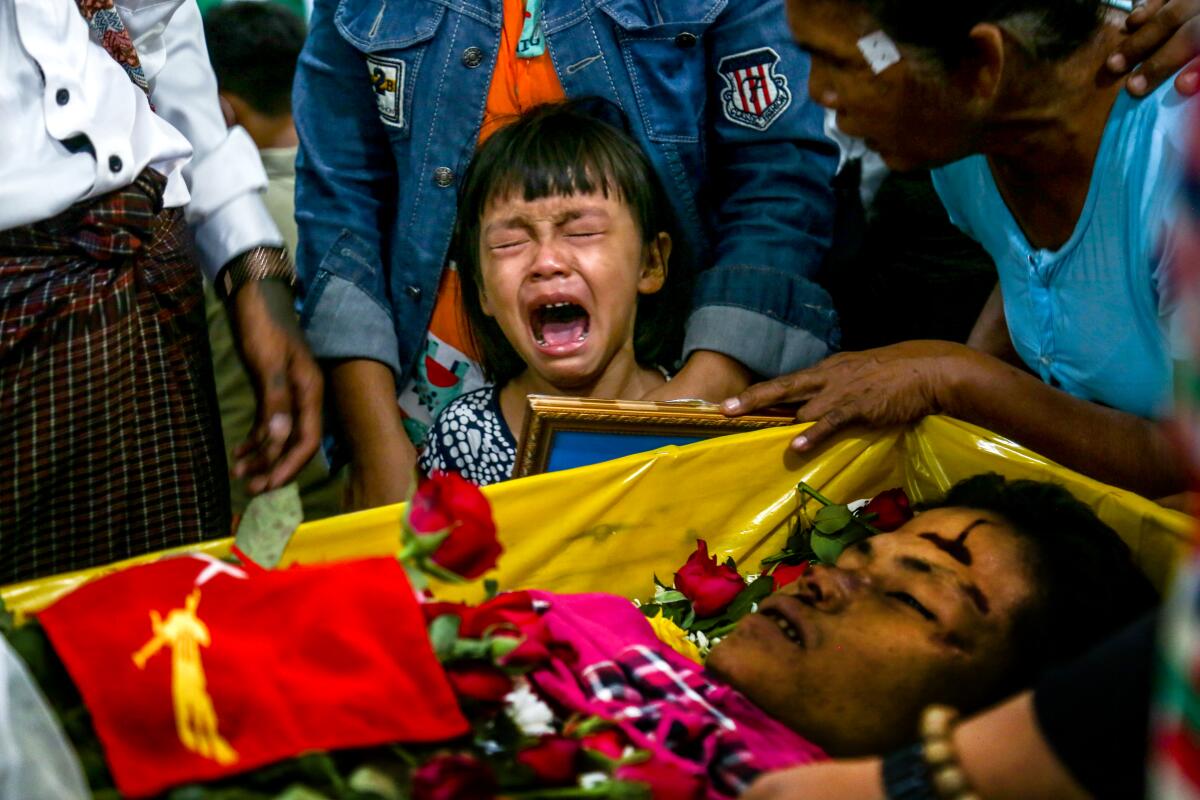
The burned victims ranged in age from 14 to 40 and included four 17-year-olds, according to a list of the dead released by Myanmar’s shadow civilian government. The oldest victim was paraplegic. The incident underscores the deepening crisis in Myanmar and the weakening chances of a diplomatic solution with a government increasingly terrorizing its own people.
“We are appalled by the alarming escalation of grave human rights abuses in Myanmar,” said Rupert Colville, a spokesman for the United Nations Human Rights Office of the High Commissioner, last week.
A separate U.N. group investigating military crimes in Myanmar, known as the Independent Investigative Mechanism for Myanmar, said it has accumulated more than 1.5 million items of evidence of abuse and atrocity, including photographs, videos, testimonies and social media posts since the military takeover.
At least 1,300 people have been killed by junta forces, including children and pregnant women, according to the Assistance Assn. for Political Prisoners, a Myanmar-based human rights group.
The sentencing of Aung San Suu Kyi is a blow to Myanmar’s democratic aspirations, but worldwide fervor over her fate had already faded.
The killings are intensifying as the junta — facing months of condemnation by the international community — is moving to crush resistance. Unarmed civilians have been bludgeoned to death, shot in the head by snipers, run over by speeding military vehicles and tortured and raped in prison. A Human Rights Watch report released this month detailed how security forces armed with assault rifles encircled protesters in a neighborhood in Yangon, Myanmar’s largest city, and killed at least 65 demonstrators and bystanders.
The rights group said 200 soldiers were involved in the operation in the Hlaing Thar Yar industrial zone, firing indiscriminately on anti-coup protesters armed with only rocks, slings and Molotov cocktails.
“We weren’t able to help those who were injured because they would shoot at us if we tried,” said one witness about the March 14 massacre. “Some people who tried to help went forward anyway and they were shot in the head and died.”
On Friday, the Myanmar Accountability Project, a London-based rights group, accused junta chief Senior Gen. Min Aung Hlaing of crimes against humanity before the International Criminal Court. The group said it submitted “clear evidence” that the use of torture in Myanmar is “widespread, systematic and the result of state-wide policies.”
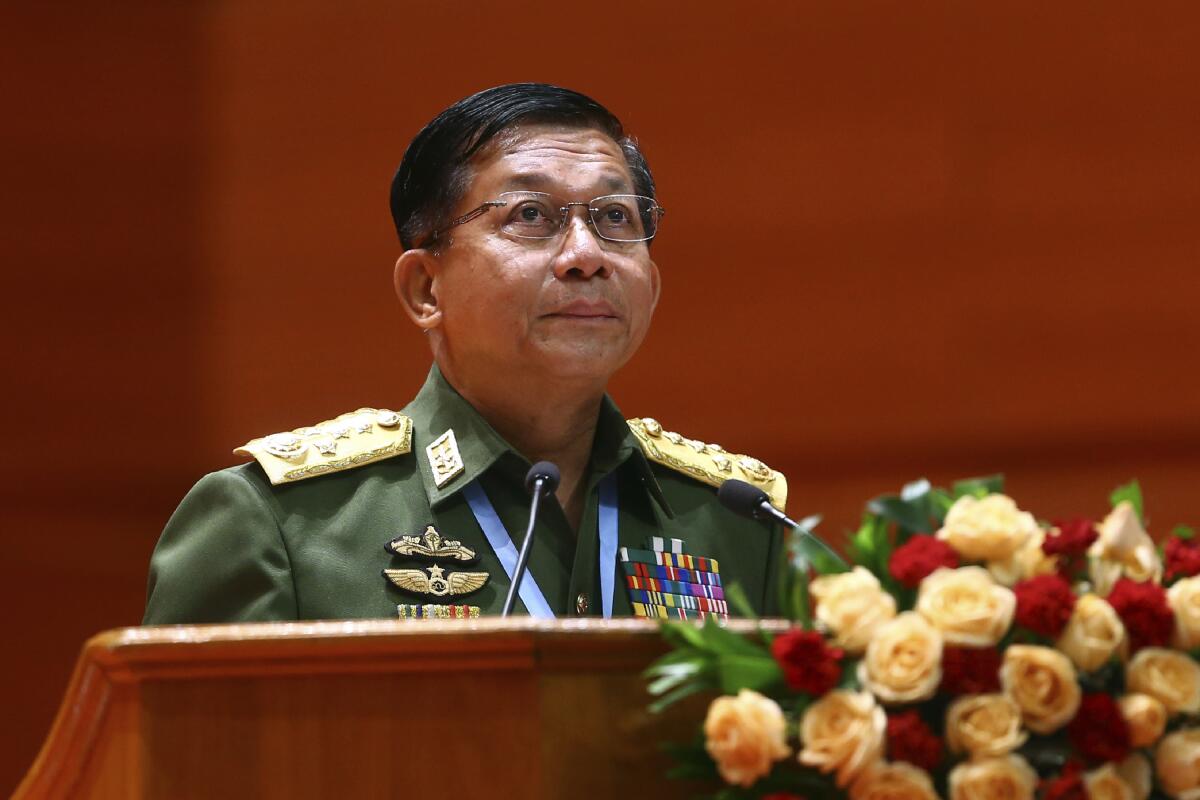
Myanmar was brought before the International Court of Justice, a different global institution, in 2019, when it was accused of genocide against the Rohingya Muslim ethnic minority. The country, also known as Burma, was defended at The Hague by civilian leader Aung San Suu Kyi, precipitating her fall from grace as a onetime symbol of human rights. The military has since silenced Suu Kyi, placing her under house arrest on spurious charges such as violating COVID-19 rules.
Myanmar has largely ignored the International Criminal Court’s order to protect the Rohingya from genocide. Still, rights groups say opportunities may exist in the future should the government fall, similar to the way former Serbian leader Slobodan Milosevic stood trial at The Hague for war crimes.
“Rigorously documenting abuses in forensic detail is essential if there are ever to be guilty verdicts,” said Chris Gunness, director of the Myanmar Accountability Project. “For universal jurisdiction to be applied, or for international justice mechanisms to kick in, it doesn’t matter if a regime cares or not. They can still be held to account.”
Aung Myo Min, minister for human rights for the civilian National Unity Government, whose members are in hiding, said it was critical that international rights groups continued to document the junta’s abuses.
“Myanmar’s legal system has been destroyed,” he said. “We only have international law to punish them for their crimes.”
Months after the Feb. 1 coup, citizens are fighting back against Myanmar’s brutal military. Many say international pressure has yielded no results.
The growing resistance to military rule — from long-established ethnic rebel groups and newly formed civilian groups known as the People’s Defense Force made up of ethnic majority Bamar — guarantees more bloodshed and brutality, analysts say.
The military, known as the Tatmadaw, has spent the last six decades waging war with striking savagery on those who challenge its authority.
“Atrocities have always been an integral part of the military’s counterinsurgency operations, which are intended not only to target rebels but also terrorize the communities that support them,” said Richard Horsey, an analyst on Myanmar at the International Crisis Group. “Troops don’t need to be told to do these things, it’s in the military culture.”
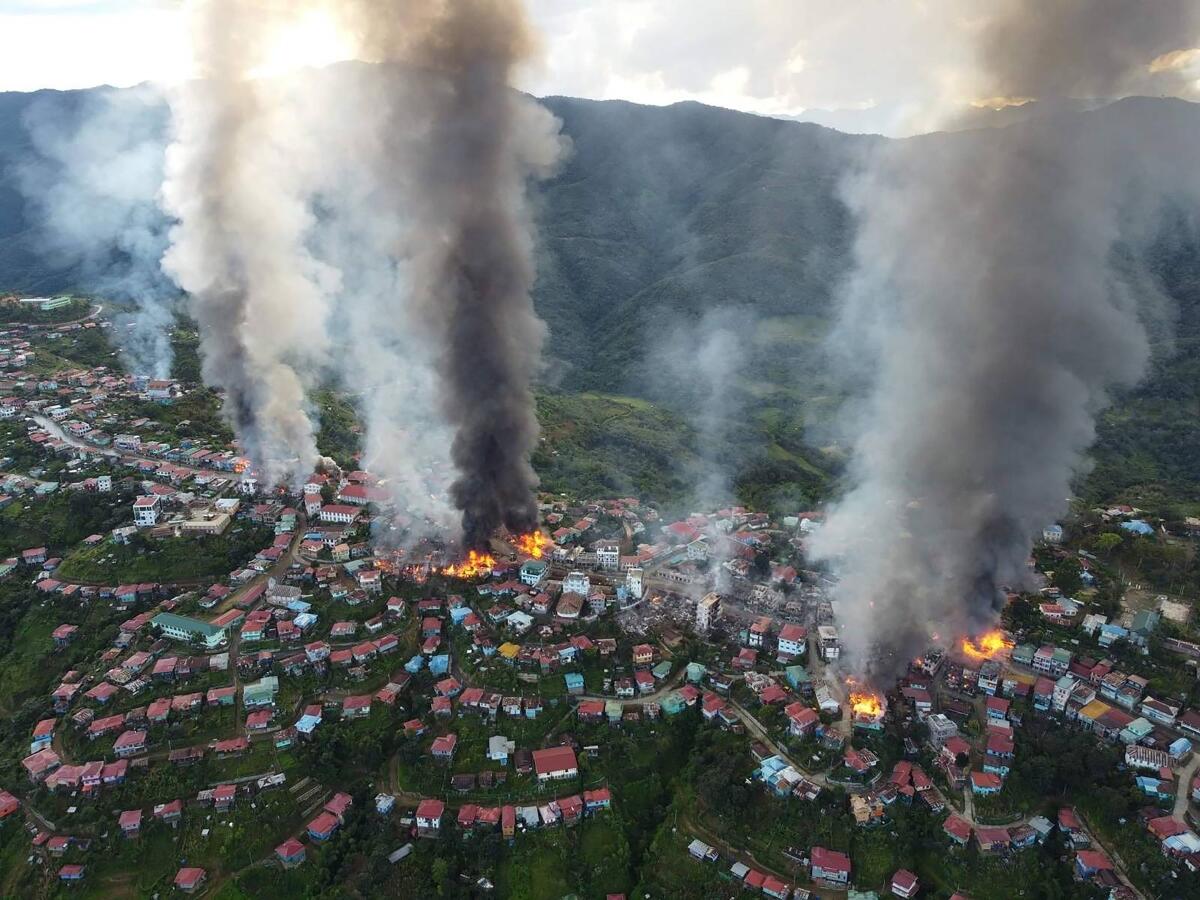
Ko Sithu, the teacher in Don Taw, thought soldiers had come to clear land mines when they approached his village the morning they burned the 11 people.
He was sitting at a tea shop around 7 a.m. when he saw about 100 soldiers on foot followed by two military trucks. The soldiers began shooting toward the village. Ko Sithu fled for cover. No more than 10 minutes later, he saw smoke rising in the distance.
When he returned in the afternoon after the soldiers had left, he saw the remains of the burned victims. They were students and betel farmers.
“We are not sure whether all of them were tied up or not, but we are sure that at least two or three people were tied,” said Ko Sithu, 35. “Some of them looked like they struggled a lot to escape.”
A body of a woman with a gunshot wound to the head was also found near the scene.
Buddhist funerals were held for all the victims the next day. Ko Sithu said none were fighters, but most of them were mistaken for members of the People’s Defense Force because of their youth.
“The military should know that the people will never be afraid of them,” he said. “These atrocities only make them angrier and more willing to fight.”
Times staff writer Pierson reported from Singapore and special correspondent Kyaw Hsan Hlaing from Bangkok, Thailand.
More to Read
Sign up for Essential California
The most important California stories and recommendations in your inbox every morning.
You may occasionally receive promotional content from the Los Angeles Times.
